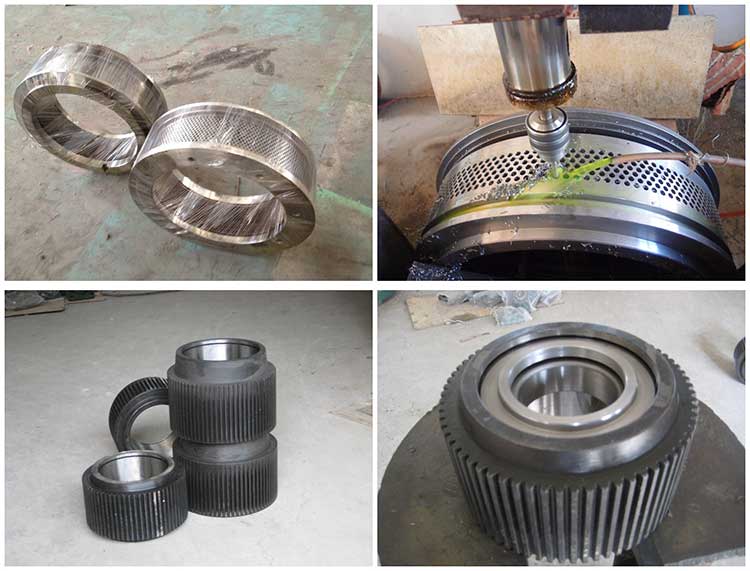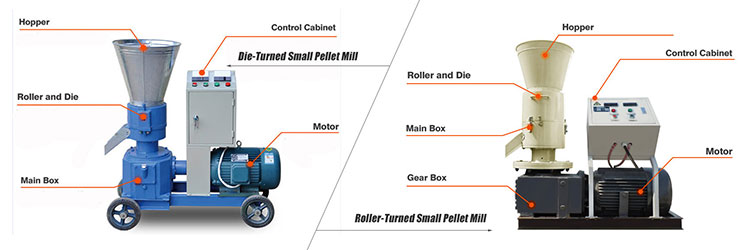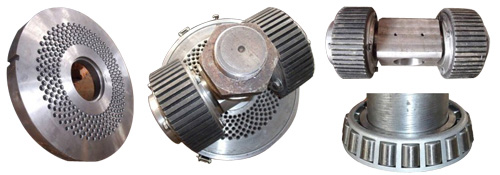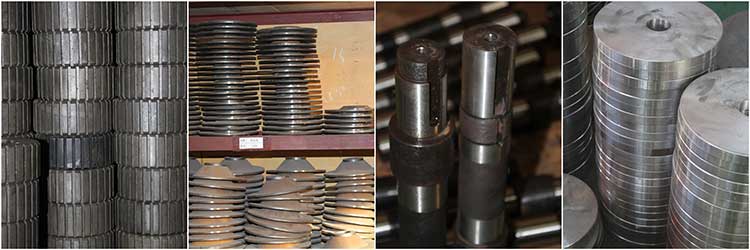
On the process of biomass pellet production, complete parts, coordinated operation and routine maintenance are the three main factors that affect the running of pellet mills. Experts from GEMCO said if the pellet mill parts cannot work normally, the performance of the machine would be unstable and the yields would get lower. Then what are the pellet mill parts? Generally speaking, a complete pellet mill consists of gearbox, flat die or ring die, roller, roller shell, bearing, pelletizing chamber, screw feeder, pellet cutting knife and so on. Here, I will show you the differences between flat die and ring die, and then tell you more details about the spare parts and easy-wear parts of wood pellet mills.

Spare Parts for Flat Die Pellet Mills
Flat die pellet mill is also called small pellet mill or household pellet mill which is widely used in small-scale factories or at home. A flat die pellet mill is made up of a solid metal plate sits below and a serious of compression rollers. When working, raw materials were first put into the hopper, then for the reason of gravity principle, they dropped down into the pelletizing chamber. In the chamber, they were compressed between the rollers and die to form pellets by going through the die holes. After getting out from the holes, the pellet bars would be cut into a certain size by the pellet cutting knife at last.

There are so many advantages of flat die pellet mills. At first, flat die pellet mills are small in size and light in weight because of the compacted configuration design; secondly, flat die pellet mills are easier to be cleaned and maintained, which reduces the cost in the process of production; thirdly, flat die pellet mills are more convenient for us to monitor the process of pelletizing by watching the pelletizing chamber which makes the experiment of indeterminate materials for materials expansion easier.
In general, flat die pellet mills are suitable for processing materials with large adhesive force pellets in small scale and medium scale pellet production, such as corn stalk, wheat bran, sawdust, peanut shell and so on. Comparing with the ring die pellet mills, they are famous for reliable operation, greater mobility, low noise and low energy consumption. However, we still have to face the fact that the low productivity of flat die pellet mills. So that, in order to expand the pellet production scale, you should choose ring die pellet mills instead.
Parts for Ring Die Pellet Mills
Ring die pellet mill or large pellet mill is specially designed on the basement of ring die for mass industrial pellet production, and ring die is the crucial part of a ring die pellet mill. Unlike the pellet mill design, the ring die is positioned vertically instead of horizontally. Raw materials were first fed from a surge bin through a variable speed conditioner above the pellet mill; then the conditioned materials would be fed into the door of pellet mill. A screw auger then feeds materials into the center of the pellet mill chamber. Inside the chamber, the rollers are stationary and the die is driven, just like a washing machine. Once in the chamber the materials are taken up by the rotating die and then compressed by the rollers.

Compared with flat die pellet mill, ring die pellet mills also have many advantages, firstly ring pellet mill do not suffer uneven roller and die wear as the inner and outer edge of the roller covers the same distance. For this reason ring die pellet mills are preferred for large scale production as the costs of roller and die consumables are perceived to be lower. Ring die pellet mills are also preferred for large-scale production as they are considered more energy efficient. In flat die pellet mill, roller slip results in extra friction during the pelletizing process, which causes more energy waste.
Because of the size and weight, the changing and maintenance of spare parts are obviously difficult. Also roller adjustment is more difficult, as the majority of ring die pellet mills require manual roller adjustment, which can only be accessed by opening the pellet mill chamber. However this is not always the case, as some now come with optional remote roller adjustment at extra cost. Cost is another disadvantage of the ring die pellet mills, as the machines themselves and the dies and rollers are generally more expensive than flat die pellet mills. Finally visibility of the pellet process, as the die and roller are encased behind a solid door, viewing the process to gain information on possible issues and correction is not possible.
Other Spare Parts for Pellet Mills
Gearbox is the core part in the pellet mill dynamical system. During the actual operation, we can change the speed of the engine to meet different needs of production. Through grinding and carburizing, the gear would have the features such as smooth transmission, great capacity, low temperature, and low noise.
Another crucial part of pellet mill is the roller. The main purpose of rollers is to mix the materials and help them get into the holes, thus the construction and roller shape are designed for preventing the slippage of the material and give a smooth surface for a better discharge. In general, a flat die pellet mills usually have two or three rollers, while the ring die pellet mill usually have two rollers.
The roller shell is the surface where raw materials are pressed against the die. As the roller shells and the die are related closely in the process of pellet production, the lifespan of roll shell is important for the mill operation. The stand to measure the roller shells are whether durable or not depends on the material, abrasion resistance and corrosion resistance.
The beatings are hidden inside of the machinery, the basic function of bearing reducing mechanical friction to ensure the pellet mill runs more efficiently and slick.
After the pellet bars were pressed out of the holes, a pellet cutting knife made of stainless steel would cut them into a set size.

Why Spare Parts Are So Important in Pellet Mills?
All in all, there are so many kinds of spare parts in pellet mills and each part has its own function during the operation of the machinery. Without the coordination of each part, the pellet mill couldn’t work efficiently and smoothly, so that it is imperative to choose high-quality spare parts and maintain them correctly. Only then can we prolong the lifespan of the machinery and get higher manufacture efficiency.



